Content
- 0.1 Ground cover rose of the ‘Akhtiar’ variety
- 0.2 'Ballerina' ground cover rose
- 0.3 'Bonica' ground cover rose
- 0.4 ‘Concerto’ groundcover rose
- 0.5 'Fair Play' groundcover rose
- 0.6 'Ferdy' groundcover rose
- 0.7 Groundcover 'Fiona' rose
- 0.8 'Fleurette' ground cover rose
- 0.9 'Immensee' ground cover rose
- 0.10 'Kent' ground cover rose
- 0.11 ‘Nozomi’ ground cover rose
- 1 'Patte de Velours' ground cover rose
- 2 'Snow Ballet' groundcover rose
- 3 Most popular varieties
- 4 Features of growing ground cover roses
- 5 Planting and leaving
- 6 Reproduction of roses
- 7 Preparing for winter
- 8 Ocean of different roses
- 9 Features of growing ground cover roses
- 10 Landscaping techniques
- 11 Popular varieties for Russia, Belarus and Ukraine
- 11.1 Low Rose Avon (orig. Avon)
- 11.2 Low drooping rose Ice Meillandecor
- 11.3 Large variety of rose - Heidekonigin
- 11.4 Large drooping rose Fiona
- 11.5 Fru Dagmar Hastrup - roses with shoots growing upwards
- 11.6 Seat selection and landing
- 11.7 Watering ground cover roses
- 11.8 Top dressing ground cover roses
- 11.9 Pruning rose bushes
- 11.10 Reproduction of ground cover roses
- 11.11 Preparing roses for winter
- 12 Outcome
IN
previous article
we learned about ground cover roses, their use and placement in the country, and now I will tell you about their best varieties.
Ground cover rose of the ‘Akhtiar’ variety

An exquisite snow-white variety created by Zinaida Konstantinovna Klimenko in the Nikitsky Botanical Garden (Yalta, Crimea) in 2003. The bush is powerful, from 70 cm to 1.2 m high, with arched shoots. The leaves are dark green, shiny. The flowers are white, cupped, large, more than 10 cm in diameter, double, collected in inflorescences, 5-6 cm long, with a strong aroma. Flowering once, very abundant. Suitable for solitary (single) and group plantings, borders, live flowering hedges and boles.
'Ballerina' ground cover rose

An unusually beautiful variety, deservedly awarded the title of "Best Classic Scrub" of the AARS Rose Competition in the USA in 1998-2001. The bush is 70-90 cm high and up to 1.2 m wide. The leaves are dark green, small. The flowers are pink with a white center, non-double (5-8 petals), 4-5 cm in diameter, with a slight aroma and hints of musk; collected in large inflorescences, bearing up to 40-50 flowers; bloom from June to November. Advantages of the variety: frost-resistant, shade-tolerant, tolerates hot summers well, moderately resistant to diseases. Planting density: 3 pcs. for 1 sq. m.
'Bonica' ground cover rose

A fine, delicate variety that can be found on the market under the names Rosa ‘Bonica 82’, Rosa ‘Meidonomac’. The bush is sprawling, powerful, 85 cm high and up to 1.1 m wide. The leaves are dark green, small. The flowers are pink, double, medium, up to 7 cm in diameter, without aroma, collected in small inflorescences. Flowering is abundant, long-lasting, the first wave is the strongest, again - weaker, in early autumn a burst of flowering is possible. Suitable for groups, wide flower borders, decorating a bed, containers, good for cutting for low vases. Cons of the variety: pink flowers quickly fade in the sun to white. In humid climates and in autumn, it is affected by black spot. Planting density: 5-6 pcs. for 1 sq. m.
‘Concerto’ ground cover rose

An amazingly beautiful variety with flowers of a rare light apricot color, created by the French company Meilland in 1995. Bush up to 1 m high, densely leafy. The leaves are green, disease resistant. Terry flowers, collected in inflorescences up to 15 flowers. The flowering is very abundant.
'Fair Play' groundcover rose
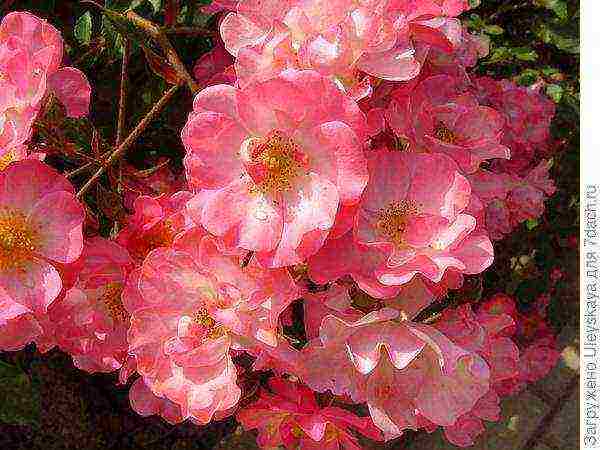
A luxurious variety created by Interplant in 1977. Spreading bush, up to 1 m high, up to 2 m wide. Leaves are dark green, large, shiny.The flowers are pink, semi-double, consisting of 15-18 petals, up to 5 cm in diameter; collected in large inflorescences, consisting of a large number of flowers (up to 50), fragrant. Abundant flowering, can be repeated until frost. Suitable for terraced slopes, flowering borders, for planting in mixborders, boles. Advantages of the variety: winter-hardy, disease-resistant. Planting density: 3 pcs. for 1 sq. m.
'Ferdy' groundcover rose
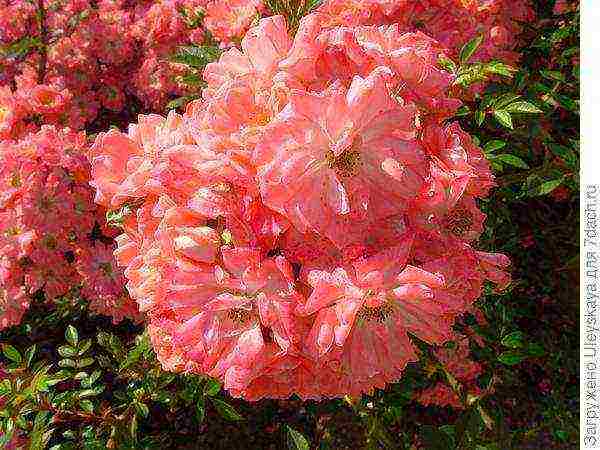
An excellent Japanese variety that has several names. In addition to the first - priority, it can be found on sale as Rosa ‘Ferdi’, Rosa ’Keitoly’. The variety was created in 1984. The bush is 80 cm high and 1.2 m wide. The leaves are green, not shiny, very small. The flowers are bright pink, semi-double, 2.5-4 cm in diameter, without aroma, collected in inflorescences. The first bloom is very abundant, blooming from summer to autumn. Used for tapeworms, in groups, on boles, in high curbs. Despite the fact that in the English reference literature regarding this variety, a winter minimum of 15 ° C is given, summer residents note that it winters well in the conditions of the Moscow region with light shelter.
Groundcover 'Fiona' rose

The personal rose variety bearing the female name is Fiona ("contemplating on God"), created in Germany by the Kordes company in 1976, so it can be found on sale under the name Rosa ‘Meibeluxen’. The bush is powerful, 80 cm high and 1.2 m wide, with arched shoots. The leaves are dark green, shiny. The flowers are bright pink, 6 cm in diameter, double, slightly fragrant, collected in large inflorescences. Flowering is abundant and prolonged from June to November (southern coast of Crimea). The variety is winter-hardy, very disease-resistant.
'Fleurette' ground cover rose
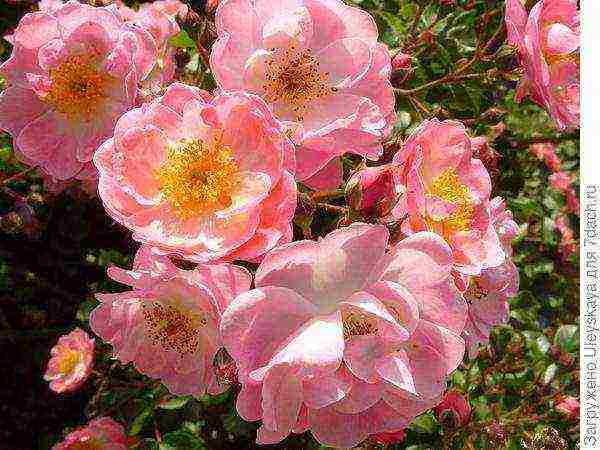
A personal variety, the name of which in translation from French means "flower". Created by Interplant in 1977. Shrub up to 90-100 cm high. Leaves are dark green, shiny. The flowers are pink, with a white center, open, semi-double, with a weak aroma. Flowering is very abundant and long, on the southern coast of Crimea from June to January.
'Immensee' ground cover rose

An excellent variety, created in Germany by Kordes in 1982. On sale it can be found under the following names: Rosa 'Grouse', Rosa 'Korimro', Rosa 'Lac Rose'. The bush is 60 cm high and up to 3 m wide. The leaves are dark green, shiny. The flowers are light pink, 4 cm in diameter, simple, collected in inflorescences, fragrant. Blooms until autumn frosts. Resistant to disease. Good on boles, suitable for decorating slopes, creating borders.
'Kent' ground cover rose
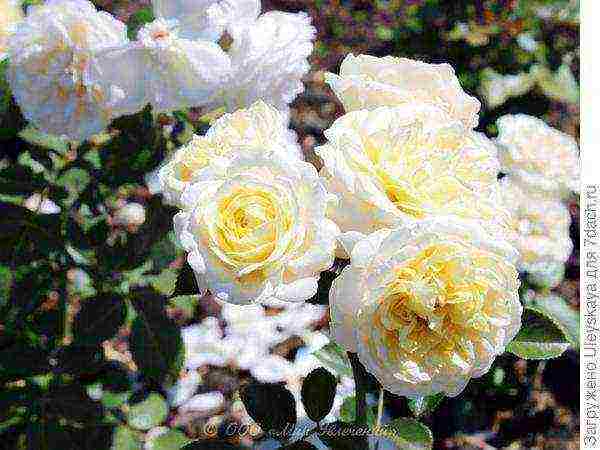
An aristocratic white variety, created in 1988. On the market it can be found under the names Rose ‘Poulcov’, Rosa ‘Pyrenees’, Rosa ‘White Cover’. The bush is 45 cm high and up to 1 m wide. The leaves are dark green, leathery, shiny. The flowers are white, semi-double, large, 4.5 cm in diameter, very fragrant, single or in inflorescences. Abundant flowering, sometimes ending only in autumn. Interesting in group plantings, mixborders.
‘Nozomi’ ground cover rose
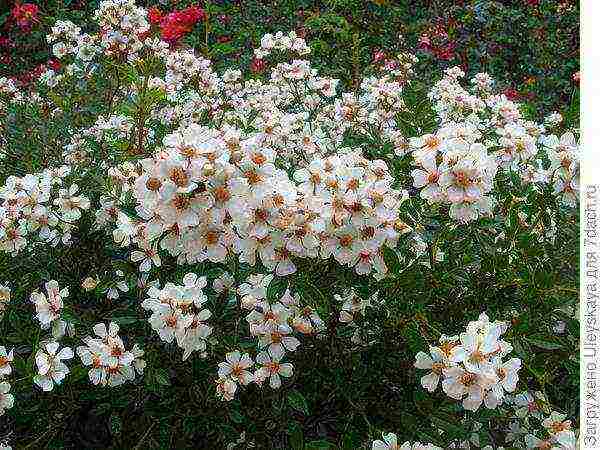
A very spectacular rose, created back in 1968, but the interest in it is enormous, since in terms of the power of flowering, the number of flowers, it has no equal. On sale, it may show up under the name Rosa ‘Heideroslein’. The bush is 45-60 cm high and up to 1.2 m wide. The leaves are small, leathery, shiny. The flowers are white, small, 2.5 cm in diameter, simple with 5 petals, with a light aroma, collected in inflorescences of 3-8 flowers, but there are so many of them that you cannot see the leaves. Suitable for decorating slopes, rocky gardens, boles. Advantages of the variety: highly resistant to diseases, winter-hardy. Planting density: 3-4 pcs. for 1 sq. m.
'Patte de Velours' ground cover rose
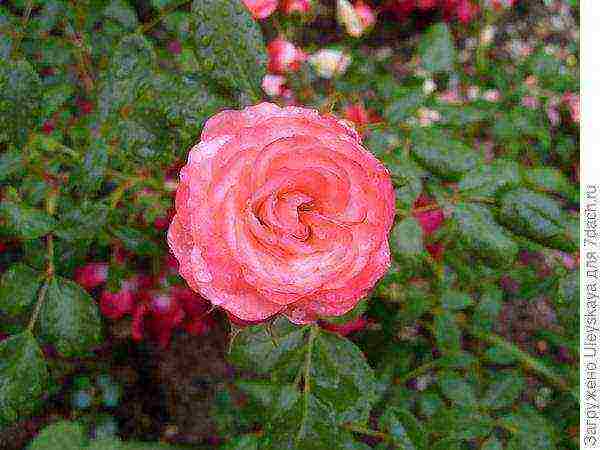
An exquisite variety created by the French company Meilland in 2000. Shrub up to 1.2 m high. Pink flowers, changing color, double, up to 40-50 petals, 5-6 cm in diameter, single or collected in inflorescences. Suitable for curbs and hedges. Timely removal of faded flowers prolongs the decorative effect of the rose.
'Rouge Meillandecor' ground cover rose

A very effective variety, created by Meilland in 1989. The bush is 60-80 cm high. The leaves are green, leathery, shiny. The flowers are red, with a white eye and yellow stamens, simple, up to 7 cm in diameter, collected in inflorescences bearing up to 10-15 flowers. Abundant flowering, long lasting.A frost-resistant variety, resistant to diseases, tolerates partial shade, grows in the 2nd year after planting. Planting density: 5 pcs. for 1 sq. m. Interesting in standard form.
'Snow Ballet' groundcover rose
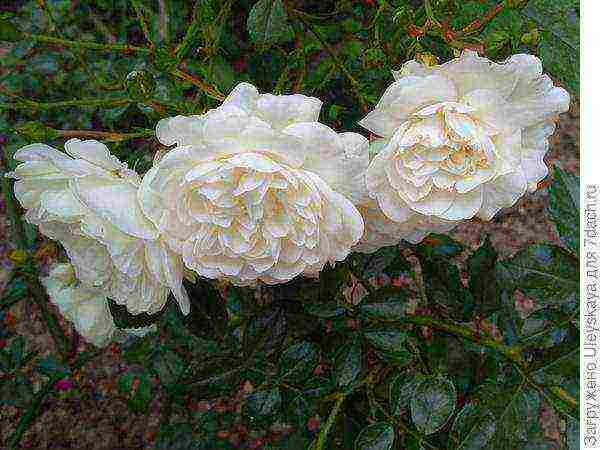
An excellent variety, the name of which translates as "snow ballet", was created by Clayworth in 1978. The bush is 70 cm high, the shoots are strong, up to 4 m long. The leaves are dark green, leathery, shiny. The flowers are white, with a subtle pink tint, up to 7 cm in diameter, densely double, very fragrant, collected in large inflorescences. Blooms from June to December (on the South Coast). Effective on boles.
'Swany' ground cover rose
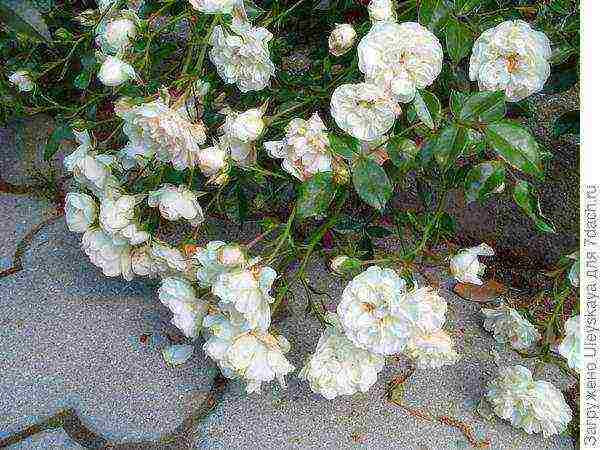
Another snow-white beauty. The variety was created in 1977. It can be found on the market under the name Rosa 'Meiburenac'. The bush is powerful, up to 75 cm high and up to 1.7 m wide, continuously forming new shoots and flowers. The leaves are green, shiny. The flowers are pure white, double, 5 cm in diameter, fragrant, single or collected in inflorescences. Abundant flowering, long lasting, throughout the summer. Suitable for landscaping slopes, rabatok, for boles.
'Weisse Immensee' ground cover rose
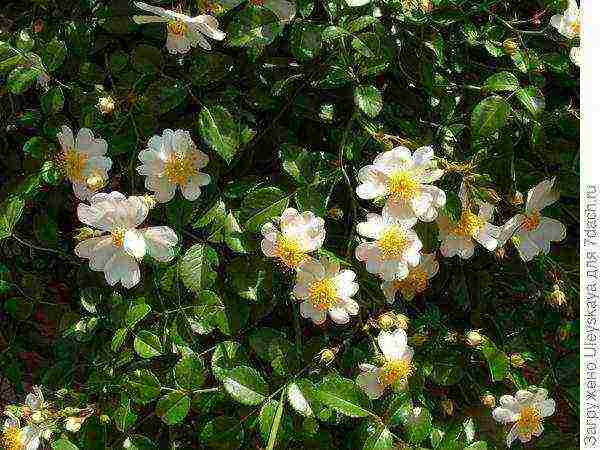
A very interesting variety, created in Germany in 1982. The bush is 0.5 m high with shoots up to 2-4 m long. The leaves are bright green, shiny. The flowers are pure white with golden stamens, up to 6 cm in diameter, non-double, collected in inflorescences, very fragrant. Flowering is abundant and long: until December on the South Coast. Suitable for boles, landscaping slopes, creating flowering hedges.
And what kind of ground cover roses are weaving carpets in your country house?
Gardeners have been growing small, branchy varieties of roses as early as the 19th century. But only at the end of the 20th century unpretentious, frost-resistant, long-blooming and very decorative ground cover roses have taken their rightful place in the arsenal of landscape designers and amateur gardeners.
Most popular varieties
Halloween (Hello)
Halloween (Hello)
Low (about 50 cm), spreading bush. They are distinguished by large, densely double flowers, which, during flowering, change color from dark red to rich cherry... Flowers are odorless, but with the richest doubleness among ground cover roses. The variety is frost-resistant, immune, blooming profusely.
Swany
Swany
The bushes are high, 75-80 cm.The crown is spreading, up to 2 m in diameter. The Swanee rose stands out for its evergreen small shiny foliage and large umbrella inflorescences... Each contains up to 20 double, white with a pink center, fragrant flowers. Winter-hardy and very ornamental shrub.
Ahtiar
Standard rose Ahtiar
A tall shrub with long (1.2-1.5 m) falling arched shoots. Large double flowers are collected in inflorescences. This landscape rose is used to create curbs and green hedges., grown in standard culture.
Ballerina
Ballerina
Tall, up to 2 m, bush with a rounded dense crown. Winter hardy, drought and disease resistant. Blooms for a long time, continuously, until the onset of frost... Simple flowers are collected in clusters. The petals are white in the center, turning pink towards the edges. During flowering, the flowers increase in size, brighten somewhat. They have a delicate musky aroma.
Scarlet
Scarlet
One of the most hardy and adaptive varieties... Bushes are low, up to half a meter. The foliage is dark, glossy. The flowers are double, deep red. Blooms profusely, all summer and autumn
Fairy
Fairy
Saplings take root quickly, shoots grow actively and in a short time form dense thickets up to 60 cm high. White, sometimes with a pink tint, double flowers are collected in a brush of 30-40 pieces... Bloom from July to frost.
Amber Sun
Amber Sun
Sprawling branchy bushes, 50-60 cm in height and in width. Drooping branches. Small semi-double fragrant flowers of all shades of yellow - from copper at the beginning of flowering to cream at the end. Prized for long flowering, cheerful decorativeness, resistance to frost and diseases of roses.
Matador
Matador
Low (up to half a meter) compact bushes. Scarlet semi-double flowers are grouped in brushes. One of the earliest flowering varieties, extremely disease resistant, hardy to environmental conditions... Often planted in hanging pots and containers.
Fiona
Fiona
Strong bush up to 85 cm, with long arched branches. Fragrant flowers are double, bright pink, medium-sized, collected in inflorescences... Blooms profusely from early June until frost. Winter-hardy immune variety.
Features of growing ground cover roses
These plants were singled out into a separate group about 50 years ago. It combines profusely flowering shrubs with wide creeping or slightly drooping arched shoots. Height from 40 cm to 2 m, crown width from 50 cm to 3 m.
Ground cover roses
Plants are well leafy, the leaves are medium-sized, shiny, form a dense green crown. Small flowers are double, semi-double or simple, collected in inflorescences, graceful and elegant.
For the ability to form dense flowering coatings, they are called carpet roses. They are used to create elements of landscape design and garden decor, therefore they are also called landscape ones.
Advantages common to ground cover roses:
- unpretentiousness, ease of care;
- frost resistance;
- immunity to diseases and pests;
- abundant long flowering;
- easy reproduction by layering;
- rapid growth and acquisition of a decorative appearance;
- from 2 years old they suppress weeds.
They are planted along the paths, in the lower tier of flower beds, in rabat beds. With their help, they create color accents on lawns, enliven gentle slopes, decorate retaining walls and terraces.... Compact varieties look great in planters and wicker baskets.
Planting and leaving
Landing dates and site selection
Carpet roses are planted in spring or early autumn, long before the onset of frost. In the regions of the middle zone and to the north, spring plantings are preferred.to give the plants time to take root and grow stronger.
The soil is chosen fertile, loamy, loose, well moistened and drained.
Roses do not tolerate stagnant moisture in the soil and high-standing groundwater. A good solution is placement on raised beds or gentle slopes.
Provide good lighting for the rose garden... At the same time, light partial shade in the sultry afternoon hours will not hurt.
Good placement for roses - on the western or southeastern steep slopes.
How to plant
The variety is selected taking into account its "adult" size, planned use, placement on the site.
 Spring is the most favorable time of the year for planting
Spring is the most favorable time of the year for planting
For a pink flower bed, dig the entire planting area into 2 shovel bayonets in depth.
Before planting, you need to carefully select plant residues, weeds and their rhizomes from the soil. Subsequently, it is difficult to remove weeds from under the thorny bushes.
Pits are prepared 50 cm in diameter and to a depth of 60-70 cm on average, but 10-20 cm longer than the length of the roots of the seedling. To plant a curb or hedge, dig a trench... The bottom is loosened by 25-35 cm.
Shoots are shortened, leaving 2-4 buds on each. Dry and damaged roots are cut off. The seedling is placed in a hole, covered with soil. Every layer of earth is watered.
From above, the soil is compacted and again watered abundantly.
Care
Young bushes are watered 2 times a week, adults - 1 time in 7-10 days. Overfilling and overdrying are undesirable.
They are fed three times a season:
- after the appearance of leaves;
- after the first wave of flowering and removal of old inflorescences;
- early autumn.
The first two times they apply complex mineral fertilizers, the third - only phosphorus and potash fertilizers.
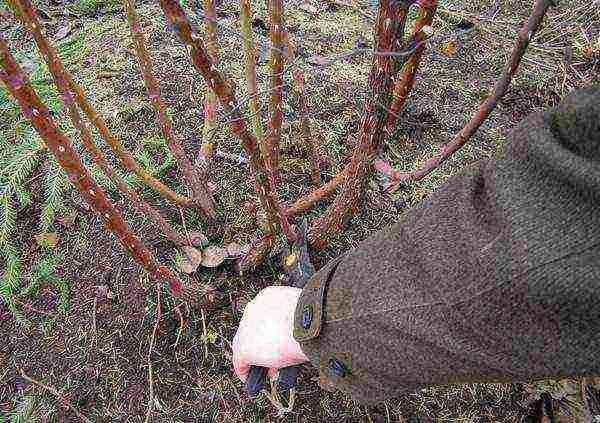 In spring, old unopened leaves are removed on rose bushes and sanitary pruning is carried out
In spring, old unopened leaves are removed on rose bushes and sanitary pruning is carried out
Cut off shoots in early spring:
- dried up;
- frozen;
- broken;
- sick.
Young plantings are mulched with bark, shavings, leaf compost or cover the soil with a black film. These measures will prevent the development of weeds.
Adult landscape roses cover the soil surface tightly and oppress weeds.
Reproduction of roses
Groundcover roses are easily propagated by layering.
In the spring, one or more long shoots are chosen. Dig into a deep groove (10cm deep) in one or more places so that there are 1-2 buds at the bottom for the formation of roots, and 1-2 buds on top, from which shoots are formed. Fasten with hooks or wooden pins, watered.
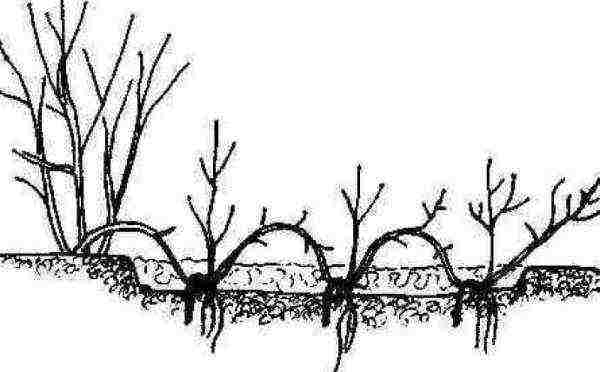 Breeding scheme for ground cover roses by layering
Breeding scheme for ground cover roses by layering
The soil is kept moist until autumn. For the winter, the shoots are covered with spruce branches... In the spring, cuttings are separated from the mother plant and transplanted to the desired location.
Preparing for winter
For better preparation for winter and ripening of shoots in the fall, watering and feeding of roses is stopped.
Ground cover plants are considered winter-hardy and do not need shelter..
In the domestic climate, this is true only for the southern regions and areas with mild snowy winters. It is advisable to protect the bushes with spruce branches or lukrasil, creating an additional air cushion.
Ground cover roses are unpretentious in care and cultivation, novice gardeners can cope with it... They respond to care and attention with abundant flowering and delight with a riot of colors, grace, spectacular decorativeness.
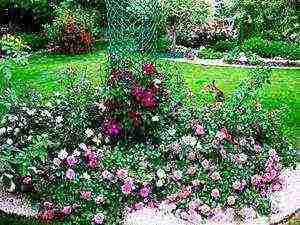 Ground cover roses refer to the broadest and ever-increasing range of low-growing shrub roses, from dwarf, branchy, upright bushes to forms that creep along the ground. Particularly popular are the "widespread" varieties, which, despite being bushy, can be grown in pots, vases and hanging baskets.
Ground cover roses refer to the broadest and ever-increasing range of low-growing shrub roses, from dwarf, branchy, upright bushes to forms that creep along the ground. Particularly popular are the "widespread" varieties, which, despite being bushy, can be grown in pots, vases and hanging baskets.
Ocean of different roses
A huge number of numerous and varied varieties of ground cover roses are characterized by long and abundant flowering periodas well as increased resistance to disease. Among this variety, you can choose types for the following design techniques:
- classic decorative landscaping of small surfaces and mounds;
- constructions of colorful borders and hedges;
- decoration with color spots of mixed perennial flower beds;
- decorating gazebos, terraces, patios, balconies and other architectural forms.
Not yet approved, but already proposed by German breeders, the official international classification of ground cover roses. The term "ground cover" is proposed to be replaced by "low-growing shrub" and introduce the next gradation, which is based on differences in the height of the bush and the type of growth of its shoots:
-
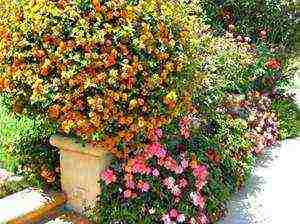 Bushes with long creeping shoots.
Bushes with long creeping shoots. - Roses with arched flowing stems.
- Broadly branching creeping bushes.
- Low, upright shrubs with a wide scattering halo.
- Small, compact shrubs with short creeping shoots.
Proven German scenery
Amber sun (Amber Sun, 2005). A versatile, wide-branched shrub with cascading shoots, for mixed flower beds, borders, tall street vases and hanging baskets. It is valued for its unusual color: young flowers and buds are copper-yellow, and closer to wilting, they brighten to a creamy yellow color.
Eskimo (Eskimo, 2006). Ideal for green and white hedges - it grows more in height (up to 0.8 m) than in width. Easy to care for - the flowers are self-cleaning, and the branches do not need pruning. White simple flowers are collected in clusters of 8 pieces.
Stadt rom (Stadt Rohm, 2007). Winner of numerous awards at international exhibitions. The undersized half-meter bushes are covered with a huge number of brushes with simple, pink flowers of a pastel-salmon shade that do not fade even in strong sun.
Candia Meidiland (Candia. Meidiland, 2007) The cultivar fell in love with its special three-color color of non-double flowers. The underside of the petals is white, the petals on top are bright red, scarlet, and the middle is painted yellow and covered with a large number of "curly" stamens.
Larissa (Larissa, 2008). A bush with arched falling branches up to 1 m long and a huge number of traditional pink double flowers, self-cleaning and collected in a brush.
Lavender Meidiland (Lavender Maidiland, 2008). The variety is intended for cultivation in flowerpots and tubs. Simple flowers of pink color with lavender tint are collected in small clusters.It is especially attractive for its color fastness and subtle, unusual odor and aroma.
Jazz (Jazz, 2008). An erect, spreading, self-cleaning bush grows up to a maximum of 70 cm. The variety is liked for its unusual multi-colored flowers - each flower has its own shade - peach, yellow, copper, orange, golden. Bush
Pretty star (Preti Star, 2008) Another upright bush (0.8 m), continuous flowering with exotic medium-sized flowers. The acid-lemon yellow color looks great against the background of small, dark green, almost black foliage.
Solera (Solero, 2009) German breakthrough breeding for breeding rose bushes with special protective properties against diseases. Widely growing shrub, with branches up to 0.7 m long. Cup-shaped double single flowers are painted in bright yellow lemon shades.
 Lipstick (Lipstick, 2011). The variety perfectly resists all diseases affecting foliage. The color of semi-double flowers is unusual: the lower part is painted white, and the upper part is an intense violet-carmine color with a pink tint. The bush is spreading, with an arcuate drop of meter-long branches. The aroma is rosehip, with a thin trail of tea rose aftertaste.
Lipstick (Lipstick, 2011). The variety perfectly resists all diseases affecting foliage. The color of semi-double flowers is unusual: the lower part is painted white, and the upper part is an intense violet-carmine color with a pink tint. The bush is spreading, with an arcuate drop of meter-long branches. The aroma is rosehip, with a thin trail of tea rose aftertaste.
Residenz (Residentz, 2012). A unique rose that perfectly resists all types of diseases and easily tolerates drought or heavy rains. It is also valued for its extended flowering period and decorative effect of flowers - the petals of semi-double racepal inflorescences are painted in an intense carmine color, with a contrasting light pink center.
Matador (Matador, 2012). Disease-resistant selection of self-cleaning compact (0.5 m) bushes of scarlet semi-double carpal roses. It is appreciated for its unusually early start of flowering.
Fashionable imitation of the legendary "Englishwomen"
One of the most famous breeders of ground cover roses is the Englishman David Austin. Its collection is so wide that it demanded to introduce subgroups for the name catalog of hybrids: 1) old, 2) musky, 3) white rose selection, 4) Leander.
Of course, his work has found a lot of fans and imitators in many countries around the world. Today, the following replicas of his famous hybrids are recognized as ground cover queens among flower queens. Here are their names.
Appleblossom Flower Carpet... Pale pink German mutation of the original English crimson original Flower Carpet. The bushes are distinguished by their special winter hardiness and increased resistance to various diseases.
Generosa... A popular imitation hybrid from the French nursery Guillot. This version is characterized by a very intense, delightful aroma, increased vitality and minimal maintenance.
Knock out... A hybrid from the USA, which is rightfully considered a triumph of modern breeding - it is so unpretentious that it will grow on any soils and areas, regardless of lighting, and in terms of winter hardiness and disease resistance, it has no equal.
World celebrities
 Scabrosa... A hybrid of rose and rugosa by maestro Robert Holmes. Purple flowers are non-double, slightly wrinkled, up to 9 cm in size. An extremely unpretentious and viable shrub (up to 1 m) that does not require maintenance. It blooms several times during the season. The resulting fruits are extremely decorative, do not require removal - they resemble medium-sized tomatoes. Cut flowers do not last long. Unlike fruits, which will be a great decoration for a dried-flower bouquet.
Scabrosa... A hybrid of rose and rugosa by maestro Robert Holmes. Purple flowers are non-double, slightly wrinkled, up to 9 cm in size. An extremely unpretentious and viable shrub (up to 1 m) that does not require maintenance. It blooms several times during the season. The resulting fruits are extremely decorative, do not require removal - they resemble medium-sized tomatoes. Cut flowers do not last long. Unlike fruits, which will be a great decoration for a dried-flower bouquet.
Rosa Schoener’s nutkana... The original flower shape (up to 9 cm) from the American Georg Schenser. Rose petals and fluffy yellow center are located on stems (1.5 m) without thorns. Numerous petals will open until a kind of dense disc forms. When properly pruned, ball-shaped shrubs look great next to plants whose foliage will be intensely colored in the fall. Withstands frosts down to -20 ° C.
Sophy's Rose... English selection, 1997. Delightful round, compact bushes of scarlet roses, re-flowering.Look great on decorative beds with herbs, mixboards or in tubs. They have a subtle pink scent and are suitable for allergy sufferers. Flowers - double, with 80 petals forming a rosette up to 7 cm. The variety is relatively winter-hardy: up to -12 ° C.
Features of growing ground cover roses
Shrub ground cover roses are very unassuming and do not require special attention.
Landing
 In this matter, ground cover pink shrubs decided to stand out among their relatives - before planting, the soil is not prepared in a hole for a new bush, but over the entire area that they will theoretically occupy during growth. The digging depth of such a site is 0.7 m, with the obligatory removal of all extraneous root systems and weeds. After planting the bush, the entire area is carefully mulched. The depth of the trenches or holes for planting - depends on the length of the root system of the seedling + 10 cm.
In this matter, ground cover pink shrubs decided to stand out among their relatives - before planting, the soil is not prepared in a hole for a new bush, but over the entire area that they will theoretically occupy during growth. The digging depth of such a site is 0.7 m, with the obligatory removal of all extraneous root systems and weeds. After planting the bush, the entire area is carefully mulched. The depth of the trenches or holes for planting - depends on the length of the root system of the seedling + 10 cm.
In regions with harsh winters, planting roses is preferable in early spring, and for areas with warmer climates - in autumn.
Care
Weeding and fertilizing every year are all the chores. In hot, dry weather, plentiful individual watering is required - once a week, 15 liters of warm water for each old bush and 2 times a week for young seedlings. It is necessary to feed with complex fertilizers 3 times:
- 2 weeks after the first foliage appears.
- After the end of the first wave of flowering.
- In autumn - only potash fertilizers.
Before winter, depending on the variety, it is better to cover some varieties of bushes with a special material laid on a low frame or spruce branches. Any variety of ground cover roses can be propagated independently using the spring technique of layering or cuttings.
Pruning
Groundcover rose bushes trimmed as needed and depending on the variety. Pruning is carried out in order to stimulate tillering or to maintain good condition. Shoots growing inward are necessarily thinned out.
Slices are performed 0.5 cm above the external buds and disinfected with garden varnish. After pruning, supportive therapy is desirable - a single spraying with preparations containing copper.
Rejuvenation of the bushes is carried out 1 time in 4-6 years - in the fall, absolutely all branches of the bush are subject to very short pruning.
Landscaping techniques
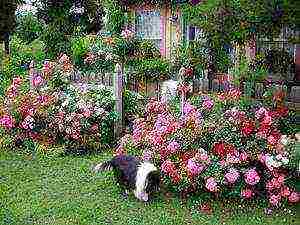 It is difficult to imagine a modern landscape design that would do without the use of ground cover roses. In addition to a special, aristocratic decorative effect, such roses can also perform a functional load - to strengthen the topsoil, thereby preventing soil leaching during floods in areas with hilly relief.
It is difficult to imagine a modern landscape design that would do without the use of ground cover roses. In addition to a special, aristocratic decorative effect, such roses can also perform a functional load - to strengthen the topsoil, thereby preventing soil leaching during floods in areas with hilly relief.
When designing a decorative site, it is worth remembering the most respectable neighbors for ground cover roses:
- the lower tier of planting - wormwood, santolina, silver sage, geranium, cuff, iris, herbs, ornamental onions;
- the middle tier of planting - dahlias, delphinium, hosta, foxglove, aerial cereals.
The latest squeak of fashion in landscape design, lasting for several seasons, is the neighborhood of ground cover roses and clematis.
The design of "living curbs" looks great in combination with monumental bouquets in garden vases.
Carpet-weaving varieties will be great decorating flowerpots or flowerpots.
A well-thought-out design is not only a decoration of the front space with compact shrub roses, but also filling the premises with a wonderful pink scent.
Popular varieties for Russia, Belarus and Ukraine
All the varieties of ground cover roses listed above in this article feel great in our climatic conditions. Below we list the name of the varieties that are most popular, good planting survival, high winter hardiness, disease resistance, unpretentious care, seedlings of which are easy can be bought in stores and nurseries:
-
 whites - Aspirin, Pearl Meyandecor, Sunny, Castelruther Spatzen, Snow Ballet, Sveny. Ivery Drift
whites - Aspirin, Pearl Meyandecor, Sunny, Castelruther Spatzen, Snow Ballet, Sveny. Ivery Drift - yellow - Sonnenshirm, Annie Dupre, Nadia Meijandekor, Vacations, Augusta Louise (with an orange border);
- pink - Penny, Palmengarten Frankfurt, Fairy, Lovely Fairy, Crazy, Rosita, Four seasons, Topolina, Bayernland Carpet;
- orange - Paul Cezanne (bush floribunda), Ethiopia, Fency, Apricot Clementine; Ninette;
- peach, cream - Pat de valur,
- red - Hello, Alpengluchen, Scarlet Meijandecor, Rouge Meijandecor, Cherry Girl, Meidy (with white lining), Rodi; Nostalgia.
- crimson and purple - Pearl Hayes, Purple Rhine, Red Fairy, Prodzhe Ecarlat. Tornado.
Having made a choice in favor of ground cover roses, you are guaranteed to free yourself from unnecessary care and become the owner of regal bushes that bloom intensively throughout the summer.
Ground cover roses and their cultivation
Ground cover roses are the perfect decoration in garden design
Roses are the most beautiful garden flowers with a delicate aroma. A blooming rose garden in the garden is an indicator of the professionalism of the gardener, and his pride. Ground cover roses are less picky about care than other groups. With the right choice of a variety, taking into account the climate in the region, as well as observing the growing conditions, they will not cause problems, and will become an ideal decoration for your site.
The best varieties of ground cover roses
Groundcover roses do not creep on the ground at all, as one might think from their name. Their bushes can reach a height of up to 1 m. From ordinary ones, ground cover roses differ in that they grow more to the sides and actively branch. Up to 300-400 buds can bloom on one bush. The entire group of ground cover roses is conventionally divided into subgroups.
Low Rose Avon (orig. Avon)
Belongs to a subgroup - low varieties up to 50 cm. This includes roses, the bushes of which quickly overgrow with horizontal shoots. The Avon shrub grows up to 40 cm high, covered with semi-double white flowers up to 3 cm in diameter.
The Avon rose features bright white flowers
Inflorescences are collected in clusters of 6-10 pieces. An overgrown bush can reach 1 m in diameter. The variety prefers light fertile soils. In cold regions, it needs winter shelter, in southern latitudes it hibernates without it. The Avon variety is resistant to many rose diseases.
Low drooping rose Ice Meillandecor
Belongs to a subgroup - low drooping roses from 50 to 90 cm. The shoots of such roses grow slowly, and have a drooping arched shape. The Ice Meillandecor variety has a bush up to 80 cm high and up to 1 m wide. The green mass is well developed, which makes it possible to mask the base of the bush.
Groundcover rose Ice Meillandecor
The flowers are white, collected in a brush. Winter-resistant variety; practically not susceptible to diseases. Suitable for middle and southern climates. Requires pruning and bush formation.
Large variety of rose - Heidekonigin
Belongs to a subgroup - large varieties from 50 to 100 cm with fast-growing creeping horizontal shoots. Vigorous vigorous plant up to 2 meters wide and 80 cm high.
 Large ground cover rose Heidekonigin with bright pink flowers
Large ground cover rose Heidekonigin with bright pink flowers
The flowers are bright pink, double, 5-6 cm in diameter. Disease-resistant frost-resistant variety. It can grow in shade and partial shade and can be used as an ampelous plant on retaining walls.
Large drooping rose Fiona
Belongs to a subgroup - large drooping roses, reaches a height of more than 1 m. The shoots have a drooping shape. A large shrub with drooping double flowers of bright pink or coral color up to 6 cm in diameter.
Groundcover drooping rose Fiona
Due to its lush greenery and large flowers, it can act as a tapeworm. Winter-resistant, practically not exposed to diseases, suitable for middle and northern latitudes.
Fru Dagmar Hastrup - roses with shoots growing upwards
Delicate non-double cupped flowers. The bush is large, up to 1.2 m tall.The plant is absolutely unpretentious, suitable for hedges and urban landscaping.
Rose Fru Dagmar Hastrup can grow in the poorest soils and does not require maintenance
Withstands contaminated and poor soil composition. Does not require shelter for the winter, can grow in any climatic conditions, pruning is not necessary.
Planting and caring for ground cover roses
Roses are not as picky as many gardeners mistakenly believe. Especially if, when organizing a rose garden, you properly prepare the ground and choose a place. Care in this case will not cause difficulties, and will be reduced to periodic feeding and pruning, and for some varieties, you will need shelter for the winter.
Seat selection and landing
When choosing a place for planting ground cover roses, keep in mind that most varieties are photophilous, and an open, sunny place is suitable for them. In addition, you need to take into account the size of an adult bush, to which the seedling will grow. It is not recommended to plant more than 5 bushes per 1 sq. m flower beds - for low varieties, and more than 1-2 plants - for large ones.
Roses should be planted in spring, late April and early May. It is also possible to plant in autumn in open ground until the end of September.
Young rose seedling in the open field
Prepare the soil thoroughly before planting. It is dug deeply, choosing roots and weeds. Then pits for plants with a depth of 60 cm are prepared, at the bottom of which organic fertilizers are poured in layers: manure, peat, compost. The bush will feed on this supply of fertilizers for the first two years, so the young plant need not be fertilized additionally.
After planting, the soil is mulched, as weeding of thorn roses will become problematic after the bushes have grown. In addition, mulch will help protect the soil under the plants from drying out.
Watering ground cover roses
A young bush requires regular watering 2 times a week. Water consumption is 10-15 liters for each plant. Watering should be carried out in the morning or in the evening, it is possible in the afternoon in cloudy weather, and only with warm water.
Top dressing ground cover roses
During the growing season, roses are fed in three stages. The first time - in the spring, immediately after the appearance of leaves on the shoots. Fertilizers should contain nitrogen, phosphorus and potassium. Complex fertilizers such as Agricola for flowering plants can be used.
The second feeding is carried out before flowering, during the ovary of the buds. The fertilizer used in the first step is suitable.
The third is autumn feeding after flowering. Its purpose is to promote the ripening of shoots and prepare the plant for wintering. Potash fertilizers are used, for example, potassium monophosphates (1-2 grams per 1 liter of water) or ash (1-2 glasses of ash per bucket of water).
Pruning rose bushes
In the first year after planting, pruning of shoots promotes tillering of the plant, in other periods it is only of a sanitary nature. Damaged, dried branches are removed, the shape of the plant is formed.
How to properly prune groundcover roses
Shoots are cut with a sharp pruner or knife at an angle of 45 degrees, at a distance of 0.5-1.0 cm above a living bud. Once every five years, the bush should be rejuvenated by shortening all shoots to a height of 25-30 cm. For processing the cuts, a garden var is used, and the whole bush is disinfected by spraying with a 1% solution of copper sulfate.
You will find full information on how to properly prune roses after flowering in our article.
Reproduction of ground cover roses
The easiest and most effective way to propagate ground cover roses is by layering. A long shoot should be bent away from the mother bush and pinned to the ground, or pressed with stones. Experienced gardeners recommend making shallow holes in those places where the shoot is deepened.
Reproduction of ground cover roses by layering
In autumn, rooted shoots must be planted from an adult bush for growing, or immersed in a box with wet sand and stored in a basement for rooting until spring, and then planted in open ground.
Also, any kind of roses can be propagated by cuttings. You will find detailed information on grafting, rooting and preparing a seedling in our article.
Preparing roses for winter
In the conditions of central Russia, roses perfectly tolerate the winter under a hat of snow.In regions with snowless winters, it is recommended to cover the bushes with geotextiles or burlap. In areas with severe frosts over roses, it is advisable to organize a shelter from spruce branches.
 Shelter a border of roses for the winter with sacking
Shelter a border of roses for the winter with sacking
Since roses do not shed their leaves for a long time, they can serve as protection from the cold and as a means of keeping snow. In the spring, the bushes and the ground under them should be cleaned of last year's litter, damaged and dried branches should be removed.
In case of severe frosts, any varieties of roses need protection, detailed information on how to help roses survive in winter can be found in our material.
Ground cover roses in the garden: photo of flower beds, use in landscape design
Shoots of some varieties can be up to 2 meters long. A well-grown bush can cover up to 3 square meters. m flower beds. By combining tall and undersized varieties, you can create carpets and "pillows" from flowering shrubs.
Rose border along the path
The classic option is a hedge along the paths, a rose garden in the "front flowerbed" at the entrance to the site and a flower garden near the house in the front garden.
 Roses in the design of the hedge
Roses in the design of the hedge
An excellent design solution is the design of an arch for vines - ground cover roses are planted at the foot of the plants climbing on a support, which cover the base of the decoration.
They are also grown to highlight garden sculptures, fountains, gazebos and wicker hedges.
Groundcover roses, photo in the garden on a retaining wall
Outcome
Groundcover roses are great for gardens in any design style, be it country or classic. Pay attention to the choice of a variety for your region so that there are no problems with frostbite, and provide the roses with everything you need - then you will not have any problems with growing, and your garden will be transformed with beautiful shrubs.


